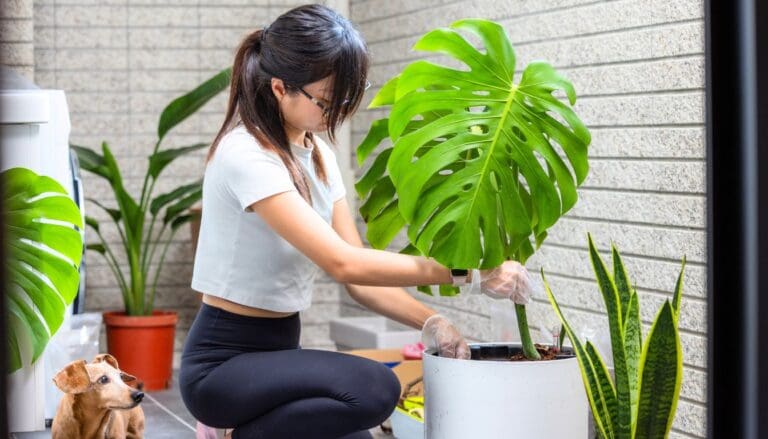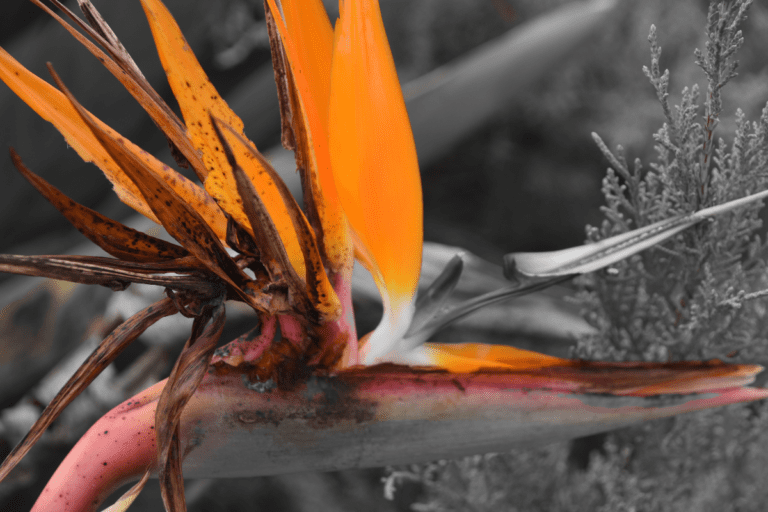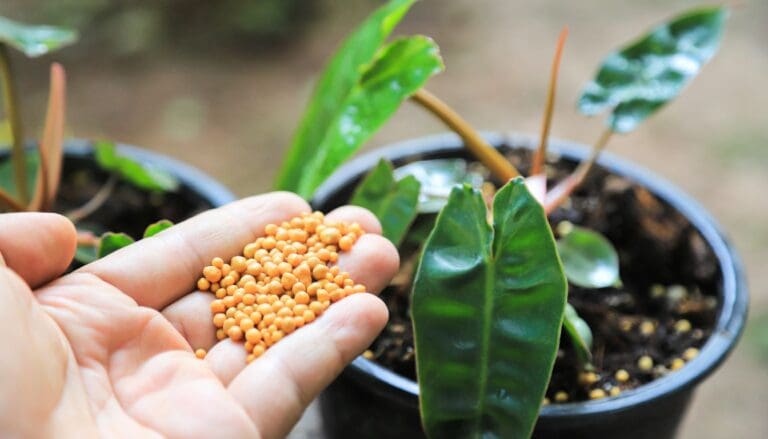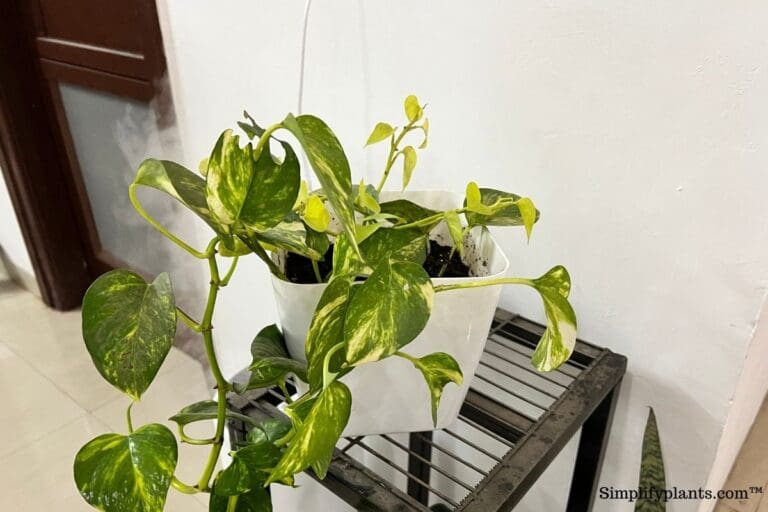What Temperature Can Croton Tolerate? (+Ideal Temperature Range)
Crotons are beautiful tropical plants with stunning variegated leaves. One common question that might pop into your head while growing crotons is what temperature crotons can tolerate. Let’s find out.
Crotons can generally tolerate temperatures as low as 40°F and even as high as 100°F, but only for a short period. The ideal temperature for crotons to thrive falls between 65-80°F. Thus, it is advised to keep the temperature at that range. Also, protect the plant from hot and cold drafts.
In this article, we will discuss the temperature tolerance of Crotons and how you can take care of them when temperatures go low.

Please note: Simplify Plants is reader-supported. Some links in the post are affiliate links and I get a commission from purchases made through links in the post.
How cold is too cold for croton?
Different Croton plants have different cold tolerance levels. This not only depends on the area where you are growing it but also on the individual plant.
People have different opinions when it comes to the cold tolerance of Crotons. While some say that crotons can tolerate as low temperatures as 40°F, many say that you must not expose the plant to low temperatures.
From my experience, I can say that mature croton plants have higher cold tolerance than young ones. Never expose young Crotons to low temperatures as it might cause irreversible damage.
Some Croton species that can handle cold quite well are:
- Dreadlocks
- Nestor
- Yellow Excurrens
- King of Siam
- Lt. Paget
However, varieties that might not tolerate cold well are Picasso’s Paintbrush and Zanzibar.
Can croton plant stay outside?
Crotons are more popular as houseplants because they come from tropical regions of Malaysia and the Pacific. Tropical plants prefer warm conditions and high humidity, which might not be attainable when grown outdoors.
But it doesn’t mean you can’t grow Crotons outside during winter. If you live in USDA zones 9-11, you can let your Croton stay outside. Areas that don’t receive frost are ideal for growing Croton outside.
However, if you reside in an area with frosty winters or are cold all year round, it will not be suitable for keeping your Croton outside. It would be best to grow Croton as a houseplant in such scenarios.
When should I bring my croton inside?
Many Croton species love the full sun, so many people consider taking their plant outside even when growing it as a houseplant. But even if you keep it outside, you should know when to bring it inside.
When summer starts to end, bring your Croton inside. You can place it near a South facing window that gets a lot of sunlight.
It would be best to keep your Croton inside throughout the winter, and when temperatures start rising at the onset of spring, you can move the plant outside.
Note: Your Croton might drop some leaves after you bring the plant inside. Don’t worry about it, as the plant will recover and stop shedding leaves within a few days.
What is the ideal range of temperature for Croton?
I have already mentioned that Crotons come from tropical regions and prefer a warm climate. Many species of Crotons prefer 6-8 hours of full sun and thrive in temperatures between 65-95°F.
However, if your Croton gets exposed to too high temperatures, it will get dehydrated, and if it gets low temperatures, it will get shocked due to the cold, so keeping it safe from both these situations is up to you.
Let’s understand how high and low temperatures can affect your Croton plant.
Effects of high temperature on Crotons

If your Croton is exposed to direct sunlight for too long or near heating sources like the fireplace or furnace, the plant will receive higher temperatures than it can tolerate.
You will notice these signs if your Croton receives too high temperatures.
- Sunburn
- Brown tips and edges
- Entire brown leaves
- Dry leaves
- Curling leaves
- Falling leaves
If you don’t want your Crotons to get exposed to high temperatures, you must:
- Place the Croton in a spot that doesn’t get too intense sunlight for too long.
- If you keep it on the balcony, patio, or garden, find a shady spot where it will stay protected from intense sunlight for too long.
- Keep the Croton plant away from fireplaces, furnaces, radiators, or other heating sources.
If your Croton is already affected by too high temperatures, you must:
- Find a suitable spot for it, as I mentioned.
- Prune the damaged leaves that will not recover.
- Water your Croton thoroughly to help it recover. Use room temperature water to avoid stressing the plant.
Also read: Can Crotons Get Too Much Sun? (Sunburn?)
Effects of low temperature on Crotons

Temperatures below 40°F can affect your Croton. If your Croton is affected by low temperatures, you will come across the following signs.
- Brown spots on leaves
- Black leaves
- Falling leaves
- Stunted growth
Low temperatures can be very damaging if you expose the plant to it for too long. But by taking care of the following points, you can protect your Crotons from low temperatures.
- First of all, keep your Croton inside the house during frosty winters.
- Keep the plant near a window that gets a lot of sunlight. A south-facing window will work well for your Croton.
- But keep the plant away from frosty windows.
- Keep it in a warm room but not too near any heating source.
If your Croton has gone through cold damage, use these steps to help it recover.
- Prune the leaves of your Croton that are damaged due to cold.
- Bring the Croton to a warmer spot that doesn’t receive low temperatures.
- Water your Croton with room-temperature water.
- Give the plant enough time to recover. It takes time for the plants to recover from cold damage.
Also read: Can Crotons Survive Winter? (Common Problems+Care Guide)
Can Crotons survive winter?
It will not be a problem for potted Crotons to survive winter as they will stay inside the house where they will receive warmth and protection from the low temperatures.
However, Crotons that grow outside in frosty and snowy conditions might not survive if you don’t protect them from the cold or bring them inside.
But even when you bring your Croton inside, you need to ensure proper care. Without the correct winter care routine, your Crotons might develop health problems.
How to take care of Croton in summer?

Spring and summer are the growing months of Crotons, and since they come from tropical regions, they prefer warm conditions. Here are some tips for taking optimum care of Crotons in the summer months.
- Unlike most houseplants, Crotons prefer full sunlight. A few species require partial shade but otherwise, try to provide at least 6 hours of direct sunlight to your Croton.
- Water your Croton to keep the soil moist but not soaked. Water your Croton after checking the soil’s moisture level and ensuring it is not wet. In general, Crotons will require 1 inch of water once a week.
- Don’t relocate the plant too often, as that can cause unwanted stress.
- Fertilize with a good fertilizer every other month. Watch the plant’s growth and adjust the fertilizer amount according to that.
- Repot the Croton during the summertime as the plant will go through less stress.
- Mist the plant to provide humidity and promote growth.
Also read: When Can You Repot Croton Plant? (+How To Repot)
How to take care of Croton in winter?
Crotons will not require the same care as the summer months in winter. You must tweak the care routine if you want to see it healthy.
Take a look at some tips for taking care of Crotons in winter.
- Don’t keep the Crotons outside in winter.
- Keep the Croton near a window that gets direct sunlight. If it still doesn’t get sufficient light, use the grow lights.
- Mist the Croton plant or use a humidifier to provide humidity as the air becomes very dry.
- Try to keep the Croton in a warm room.
- Reduce watering during winter. You can water bi-weekly after making sure that the soil is dry.
- Stop fertilizing during the winter months.
- If you have an outdoor Croton plant, mulch the soil to provide warmth and prevent the roots from freezing. You can also cover your Croton with a gardener’s blanket.
Final words
Crotons are hardy tropical houseplants that can tolerate a wide range of temperatures.
While some Crotons can tolerate temperatures as low as 25-30°F, some might not do well in 40°F. So the temperature tolerance can also depend on the species of your Croton.
Like low temperatures, Crotons will also not do well when the temperatures are higher than their tolerance level, which is 80-100°F. Therefore, you must try to maintain suitable temperature levels of 65-95°F.
You must neither expose the Croton plant to frost and freezing temperatures nor keep it under intense direct sunlight for too long. Both these conditions can deteriorate the health of your Croton.
You must bring the Croton to a shadier spot during scorching summers and bring it inside the house during frosty winters.
Reference: Sciencedirect, Wikipedia, Wikipedia, Britannica, CABI, Academia, University of South Florida, The University of Georgia.
Recommended Garden Supplies
| Product Image | Our Recommended Gardening Supplies | Check Offers! |
|---|---|---|
Top Top
Top
Top
Top
Top
Top
Top
Top | rePotme Houseplant and Tropical Classic Potting Soil Mix | Check Offer On Amazon |
 Top
Top
Top
Top
Top
Top
Top
Top | Espoma Organic Indoor Plant Food | Check Offer On Amazon |
 Top
Top
Top
Top
Top
Top
Top
Top | GooingTop LED Grow Light 6000K Full Spectrum Clip Plant Growing Lamp | Check Offer On Amazon |
 Top
Top
Top
Top
Top
Top
Top
Top | Soil Moisture Meter | Check Offer On Amazon |
 Top
Top
Top
Top
Top
Top
Top
Top | Govee Hygrometer Thermometer, Bluetooth Enabled! | Check Offer On Amazon |
 Top
Top | LEVOIT Humidifiers for Large Room(Best For Plants) | Check Offer On Amazon |
 Top
Top
Top
Top
Top
Top
Top
Top | Upgraded DIY Automatic Drip Irrigation Kit, 15 Potted Houseplants Support | Check Offer On Amazon |
 Top
Top
Top
Top
Top
Top
Top
Top | Stainless Steel Heavy Duty Gardening Tool Set | Check Offer On Amazon |
 Top
Top
Top
Top
Top
Top
Top
Top | Bonide Insecticidal Soap | Check Offer On Amazon |
 Top
Top
Top
Top
Top
Top
Top
Top | Bonide 32 oz Spray Neem Oil for Organic Gardening | Check Offer On Amazon |
 Top
Top
Top
Top
Top
Top
Top
Top | Garden Safe Fungicide | Check Offer On Amazon |






